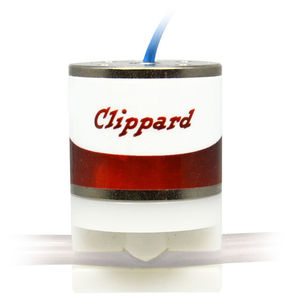
- Company
- Products
- Catalogs
- News & Trends
- Exhibitions
Pinch valve NPP - Pneumatic Valves pneumaticdosingfor wastewater


Add to favorites
Compare this product
Characteristics
- Type
- pinch
- Operation
- pneumatic
- Function
- dosing
- Media
- for wastewater, for gas, for air
- Applications
- chemical, beverage, hygienic, laboratory, food, for medical devices
- Number of channels
- 2/2-way
- Other characteristics
- compact, normally open
- Pressure
Min.: 0 bar
(0 psi)Max.: 17 bar
(246.6 psi)- Temperature
Min.: 0 °C
(32 °F)Max.: 110 °C
(230 °F)
Description
Clippard’s NPP Series 2/2 pneumatic pinch valves are air-piloted devices designed to open or close tubes for controlling flow of liquids and gases. Other valve types have internal passages that may cause small amounts of fluid to remain in the valve. Pinch valves have no areas or dead volume where fluid can become trapped. Only the inside of the tubing has contact with the fluid.
Common industries that utilize pinch valves for the benefit of isolating fluid from a mechanical valve including drug dispensing, laboratory equipment, wastewater, medical devices, chemical, food and beverage equipment, ceramic/glass/plastic, and solids handling.
• Small, compact design
• Normally-Open or Normally-Closed styles
• Hygienic and easy to clean (replace tubes)
• Can handle whole blood and particulate matter
• Unobstructed flow path
• Each valve comes with 30 cm of selected tubing
• Wide variety of easily replaceable tubing sizes and
materials available
• 100% tested
Valve Type: 2/2, Normally-Open & Normally-Closed
Medium: Air, Water, Gas, & Compatible Fluids
Max. Pilot Pressure: 17 bar
Operating pressure: 0 to 2 bar
Temperature Range: 0 to 110°C
Mounting: #4-40 or M3
Wetted Materials: Medical or Food Grade Silicone, or Polyurethane
RoHS Compliant
Catalogs
No catalogs are available for this product.
See all of Clippard‘s catalogsRelated Searches
- Clippard valve
- Clippard manual valve
- Clippard control valve
- Ball valve
- Stainless steel valve
- Clippard water valve
- Clippard pneumatic valve
- Clippard threaded valve
- Clippard solenoid valve
- Regulating valve
- Stop valve
- Clippard flap valve
- Clippard check valve
- Electric valve
- Clippard gas solenoid valve
- Directional control valve
- Clippard NC solenoid valve
- Clippard 2-way solenoid valve
- Clippard pneumatically-operated valve
- Pressure limiter
*Prices are pre-tax. They exclude delivery charges and customs duties and do not include additional charges for installation or activation options. Prices are indicative only and may vary by country, with changes to the cost of raw materials and exchange rates.


